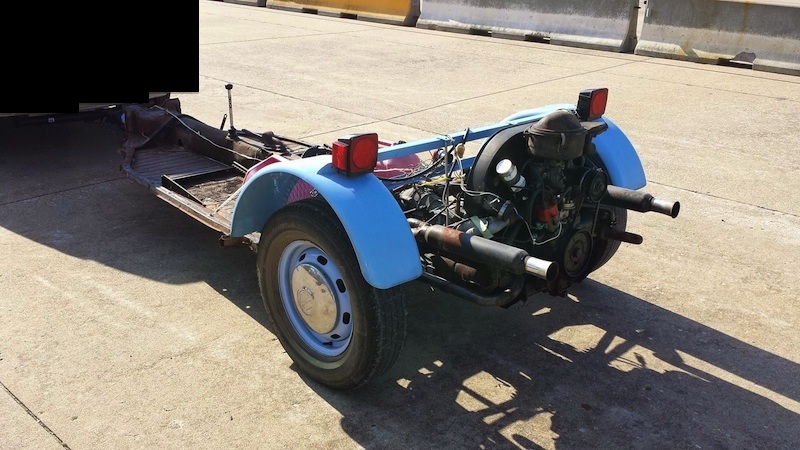On my Christmas travels, I linked up with a gent who was inspired by my pusher trailer musings and simply got 'er done! He used the entire pan(chassis) of an old VW beetle, welded a ball coupler to the front frame head, and just tied the throttle wide open! He drove two hours from home to meet us and allow me to experience driving the pusher without any detours on our part! After a 122 mile drive, we discussed the details over a nice dinner.
Operation is as follows; drive around town towing the pusher off and in Neutral, and then pull over and shift into 4th at the top of an on-ramp, lug the engine up to speed and flip on the ignition. Then it roars to life and starts adding power. Since his EV weighs over 4000 lb and has cruise control, the pusher engine can push it's little heart out without regard for hills or the speed limit. The cruise control simply brings in more regen to scrub off speed, or adds electric power to help climb hills. His pusher engine is completely unenclosed and has dual unmuffled exhausts, yet the engine is very quiet way back there. I had to roll down the window to listen for pinging, etc. when deliberately stressing the engine (briefly). Pusher operation was smoother and simpler than I had dared to imagine, and when deliberately operating in charge-sustaining mode (stayed above 80% SOC), we got 22 mpg at 55 mph over 122 miles on a very hilly highway; exactly his long-term average. Not bad for a salvaged aircooled engine with noticeable blow-by pushing nearly 5000 lbs through the mountains.
The gent and his EV particulars are anonymized for now due to his concerns about OEM warranty coverage. He is racking up EV miles at an unnatural rate. ;-)
Added Technical tidbits follow.
-Since the engine's too quiet to reliably hear if it experiences trouble, and the cruise control seamlessly maintains speed if the engine lags, he's tied the oil pressure sender to a LOUD backup alarm. This means that if the engine stops running with the key on (such as if you turn the key on while stopped) the trailer starts screeching horribly. He added this feature after blowing up his first engine...

-Even with the full VW pan and frame head (but no axle beam) and forged steel Bulldog coupler welded in place, tongue weight was very manageable, I'd estimate a bit over 50 lb.
-Fuel tanks were just two 5 gal plastic cans with a modified cap passing through the fuel hose.
-As a safety, he added a magnetic reed switch that depowers the engine when brakes are applied. This created an unwanted side effect causes the engine to surge on and off in sync with the turn signals! You see, trailer wiring harnesses combine the brake and turn signal into a single filament, so the turn signals were cutting power to his ignition coil! A fix is in the works.
This generous gent also presented me with a wiring harness that would literally turn any engine (or entire towed car) into a pusher with just two quick wiring connections. It's a 12 Volt 'cigarette lighter' plug that uses the tow vehicle accessory outlet to power the pusher's ignition coil. Of course, that's not quite as safe as his brake-interlock design because the engine will push until someone manually pulls the plug, but it'll do for testing purposes.
Thusly inspired, I installed it on the olde JB Straubel pusher trailer last night, and intend to do a road test tonight. I found some faults in JB's old control wiring, so bypassed that mess and wired it direct. I also fabbed up a better gearshift lever than the old vice-grips, and cut away the questionable fuel hose and tank selector valve, re-installing a single marine gas tank on the only properly fabbed bracket.
Today I'm ordering the last part for my planned electric clutch actuator, which will enable the operator to declutch without stopping and walking back to the trailer. That'll be good for unplanned stops and seamless merging onto the highway.















